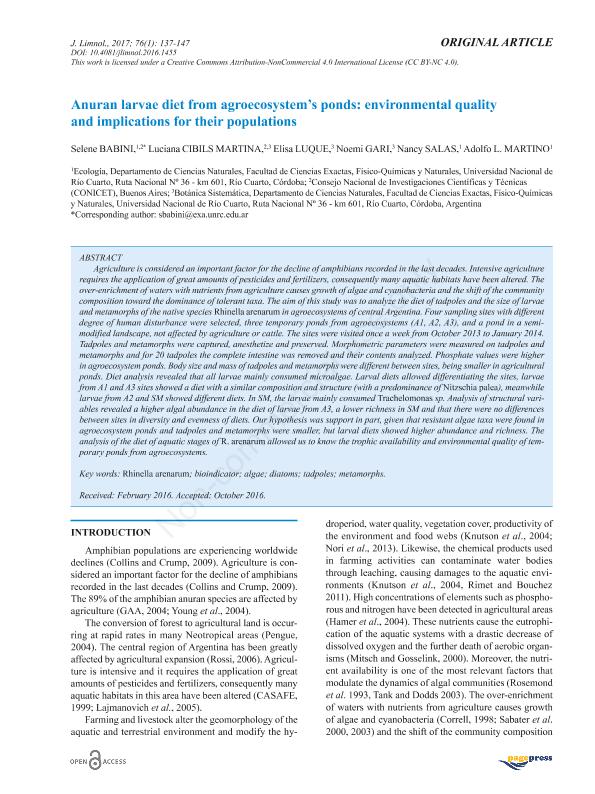Artículo
Anuran larvae diet from agroecosystem’s ponds: Environmental quality and implications for their populations
Babini, María Selene ; Cibils Martina, Luciana
; Cibils Martina, Luciana ; Luque, Elisa; Gari, Noemi; Salas, Nancy Edith; Martino, Adolfo Ludovico
; Luque, Elisa; Gari, Noemi; Salas, Nancy Edith; Martino, Adolfo Ludovico
 ; Cibils Martina, Luciana
; Cibils Martina, Luciana ; Luque, Elisa; Gari, Noemi; Salas, Nancy Edith; Martino, Adolfo Ludovico
; Luque, Elisa; Gari, Noemi; Salas, Nancy Edith; Martino, Adolfo Ludovico
Fecha de publicación:
01/2017
Editorial:
Cnr Ist Italiano Idrobiologia
Revista:
Journal of Limnology
ISSN:
1129-5767
e-ISSN:
1723-8633
Idioma:
Inglés
Tipo de recurso:
Artículo publicado
Clasificación temática:
Resumen
Agriculture is considered an important factor for the decline of amphibians recorded in the last decades. Intensive agriculture requires the application of great amounts of pesticides and fertilizers, consequently many aquatic habitats have been altered. The over-enrichment of waters with nutrients from agriculture causes growth of algae and cyanobacteria and the shift of the community composition toward the dominance of tolerant taxa. The aim of this study was use to analyze the diet of tadpoles and the size of larvae and metamorphs of the native species Rhinella arenarum in agroecosystems of central Argentina. Four sampling sites with different degree of human disturbance were selected, three temporary ponds from agroecosystems (A1, A2, A3), and a pond in a semimodified landscape, not affected by agriculture or cattle. The sites were visited once a week from October 2013 to January 2014. Tadpoles and metamorphs were captured, anesthetize and preserved. Morphometric parameters were measured on tadpoles and metamorphs and for 20 tadpoles the complete intestine was removed and their contents analyzed. Phosphate values were higher in agroecosystem ponds. Body size and mass of tadpoles and metamorphs were different between sites, being smaller in agricultural ponds. Diet analysis revealed that all larvae mainly consumed microalgae. Larval diets allowed differentiating the sites, larvae from A1 and A3 sites showed a diet with a similar composition and structure (with a predominance of Nitzschia palea), meanwhile larvae from A2 and SM showed different diets. In SM, the larvae mainly consumed Trachelomonas sp. Analysis of structural variables revealed a higher algal abundance in the diet of larvae from A3, a lower richness in SM and that there were no differences between sites in diversity and evenness of diets. Our hypothesis was support in part, given that resistant algae taxa were found in agroecosystem ponds and tadpoles and metamorphs were smaller, but larval diets showed higher abundance and richness. The analysis of the diet of aquatic stages of R. arenarum allowed us to know the trophic availability and environmental quality of temporary ponds from agroecosystems.
Palabras clave:
Algae
,
Bioindicator
,
Diatoms
,
Metamorphs
,
Rhinella Arenarum
,
Tadpoles
Archivos asociados
Licencia
Identificadores
Colecciones
Articulos(CCT - CORDOBA)
Articulos de CTRO.CIENTIFICO TECNOL.CONICET - CORDOBA
Articulos de CTRO.CIENTIFICO TECNOL.CONICET - CORDOBA
Citación
Babini, María Selene; Cibils Martina, Luciana; Luque, Elisa; Gari, Noemi; Salas, Nancy Edith; et al.; Anuran larvae diet from agroecosystem’s ponds: Environmental quality and implications for their populations; Cnr Ist Italiano Idrobiologia; Journal of Limnology; 76; 1; 1-2017; 137-147
Compartir
Altmétricas



